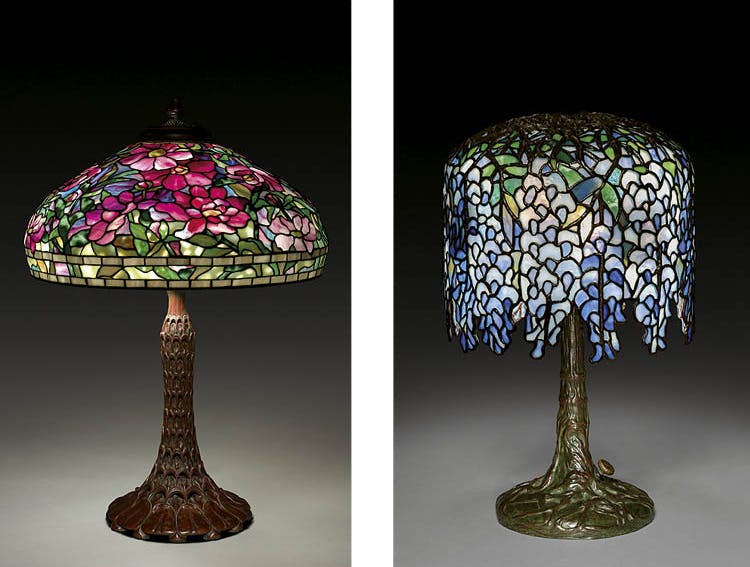
Tiffany in Bloom
- Magazine Article
- Exhibitions
A bouquet of splendid stained glass lamps

Peony Table Lamp, c. 1901–10. Probably by Clara Wolcott Driscoll (American, 1861–1944), Tiffany Studios (America, New York, 1902–1932). Leaded glass, bronze; h. 80 cm. Bequest of Charles Maurer, 2018.260 (left)
Wisteria Table Lamp, c. 1902–10. Clara Wolcott Driscoll, Tiffany Studios. Leaded glass, bronze; h. 43.2 cm. Bequest of Charles Maurer, 2018.261 (right)
Just as they did more than 100 years ago, the words “Tiffany lamp” conjure an image of artistic beauty, a bird of rare plumage, or a kaleidoscope of color formed from thousands of pieces of glass. With the flick of a switch these otherwise dark, dormant puzzles come alive to create a glowing painting in the round—a marvel of craftsmanship that heralded the introduction of electric light. Louis Comfort Tiffany, who developed a passion for stained glass as a way to bring Nature’s splendid color into the home, responded to the emerging artistic and craft movements at the turn of the 20th century with this singular contribution to the world of design.
In the 1870s a renewed emphasis on natural landscapes ushered in a generation of cottage gardeners who delighted in planting swathes of perennials. Tiffany was among those who championed the lush, sometimes wild-looking displays of varied floral species in the garden at his Long Island estate, Laurelton Hall. He encouraged his designers to take inspiration from his garden by shipping fresh cuttings almost weekly to his studios. Ohio native Clara Wolcott Driscoll created patterns based on the colorful blooms of spring, such as those for the Peony and Daffodil lamps, that became among the most successful of Tiffany’s production.

As a graduate of the Western Reserve School of Design for Women (now Cleveland Institute of Art), Driscoll brought a studied sense of natural forms and artistic composition to her job as a designer in Tiffany’s lamp department. Her ability to transform the vibrant colors and seductive blooms of plant life into shimmering lamp designs, using carefully placed pieces of glass, won her not only the respect of her peers but also the attention of Tiffany. She rose to become the head of the Women’s Glass Cutting Department and the principal designer of most of the firm’s floral-themed lamps. Her success as a designer in such a male-dominated industry was a rare feat at the time and brought acclaim to both herself and her family in Tallmadge, Ohio.
Tiffany and his designers re-created the ever-changing qualities of natural light using the light and dark tonal effects of the glass when illuminated with electric lamps. Although incandescent bulbs had become more widely available in the 1890s, most households—even those of the wealthy—were not wired for electricity. Tiffany originally designed his lamps with an oil-burning apparatus, consisting of a reservoir and a double wick and chimney, as well as an electric attachment. He cleverly predicted, though, that electric households would soon become commonplace, so he moved to all-electric designs by 1910, greatly increasing the illumination and appeal of his lamps.
Tiffany’s fascination with naturalistic forms and patterns resulted in lamps of breathtaking colors, from deep reds, blues, greens, and yellows to soft pale whites, pinks, and creams. They also reveal a Japanese aesthetic, emphasizing the sublime beauty of Nature, which was the underpinning of art reform movements, especially Art Nouveau, around 1900.

When Tiffany began collaborating with glass engineers on new types of production, his aesthetic ambitions were finally realized in the development of Favrile glass, a term he invented that sounded French and connoted elegant, handmade objects. Largely through his marketing ability, Favrile glass became America’s greatest contribution to the Art Nouveau movement. His works were exhibited at international expositions; at galleries in major European cities, where his creations were bought by many museums; and in his store in Manhattan, known as the Tiffany Glass and Decorating Co., later Tiffany Studios. From the outset, he used Favrile glass in mosaic panels, stained glass windows, and his expressive line of table and floor lamps.
By 1900 Tiffany had expanded his empire by increasing the firm’s production of “fancy goods,” including inkstands, candlesticks, clocks, small boxes, desk sets, and other functional objects. Along with the array of artistic glass designs made in his factory in Corona, Queens, works in ceramic, bronze, other metals, and even jewelry abounded. These smaller, more affordable luxury items were designed with as much thought to artistry as the great stained glass windows and lamps through which the firm enjoyed unrivaled success.
Most of the works in this exhibition have recently joined the museum’s collection through the generous bequest of Charles Maurer, a Cleveland industrialist and renowned collector of the works of Louis Comfort Tiffany. Tiffany in Bloom celebrates this extraordinary gift with an opportunity to view the artist’s great lamps together in a bouquet of splendor.
Cleveland Art, November/December 2019